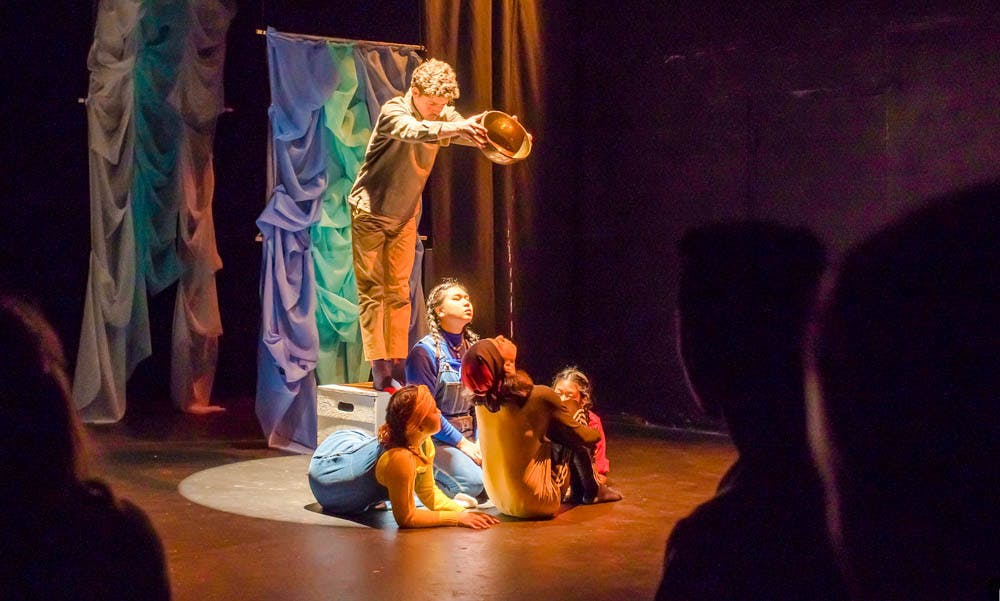Exploring trans identity, diaspora and mental illness, a Movement/Theater performance titled “danceveil” debuted last Thursday at the Upspace that examined the link between the physical body and the spiritual identity. Choreographed by Brian Solomon ’19, the show shares the various and complex diasporic experiences that Solomon and the performers have personally faced. The experimental contemporary dance piece investigates intergenerational relationships that transcend time and space through the stories of two fictional characters.
The performance featured seven dancers, including Vanessa Garcia ’20.5 and Alexis Roman ’21 who played the lead roles of Eldra and Miriyam, respectively. The first section of the show follows the journey of Eldra, a character who Solomon describes as existing “in the time/space bridge between the ‘homeland’ … and the diaspora,” according to the program. In the next section, the show focuses on the story of Miriyam, who explores their genderqueer identity through an investigation of their childhood memories. In the final section of the show, the two characters interact and help each other heal. Focused on the storytelling, Solomon added that the choreography revolves less around technique and more on bodily expression through movement.
Solomon explained in the program that Eldra and Miriyam actually exist in different time spaces, and the final portion of the show in which they meet is an imagined experience. The stage of the show physically represented the separation of time and space through six semi-transparent, white-and-blue drapes or veils hanging from the ceiling. When the performers danced behind the drapes at various points throughout the show, their movements were depicted and accentuated through the shadows of their bodies on the fabric. The space behind the drapes represents the concept of homeland of the past, and the space of the stage in front symbolizes the diasporic present, Solomon wrote in the program.
Growing up in a Jewish household, Solomon has a personal relationship to the notion of diaspora. Solomon wrote in the program, “We (the Jewish) are a ‘people’ spread across the world, dispersed through millennia of conversation.” In addition to the theme’s other central topics of trans identity and mental illness, Solomon portrayed cultural diasporic experiences with references to Jewish songs and dances as well as Filipino languages and gestures that were inspired by Roman’s and Garcia’s cultural backgrounds.
Solomon said that the inspiration for this show came from the death of Solomon’s grandmother, and the performance actualizes the conversations that Solomon desired but was never able to have with her. Solomon wrote in the program, “We imagine (and hope) that our ancestors will willingly embrace us as whole people, that they will engage with our entire expansive self and not write us off like so many others in our lives do.” The idea of the expansive self is portrayed through the three other dancers, named Mi, Ri and Yam, who represent the components of Miriyam’s multifaceted identity.
Referencing a line from poet Aja Monet’s “An Offering,” the full title of the show is “danceveil ~ spiritual beings with human experiences |” and wishes to address the physical and social notions of the body. As Monet discovered the multiplicity of her body in her poem, Solomon wishes to describe the way social construction of and personal attachment to physical existence limits the spiritual possibilities of the body.
Because the performance was inspired by such intimate stories and personal identities, Solomon wanted the cast members to share these experiences. Garcia and Roman both felt a connection to and identified with the characters they played. The affinity was strengthened when Solomon incorporated the dancers’ life experiences into the performance through hour-long conversations during rehearsal. Roman said scenes such as the one depicting a quinceanera was inspired by their own childhood memories. Garcia added that the “fidgeting, shaking and sharp” movements that they performed were also based off their own experiences with mental illnesses.
Audience member Shira Abramovich ’20.5 said, “I’m also a child of immigrants and resonate with some of the themes of the show,” adding that the duets between Eldra and Miriyam were particularly evocative.
Investigating themes of ancestry and identity, Solomon wanted to help the audience members who shared diasporic experiences to realize their ability to transcend time and space through imagination and recreation. In this intergenerational piece of fictional dialogues based on real experiences, Solomon hoped to convey that “even if … (your ancestors) didn’t treat you the way you want to be treated, that we at least have the power to reimagine those memories and make them work for us.”





